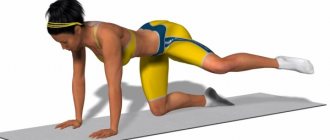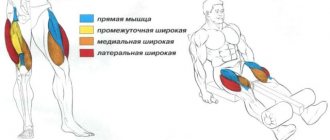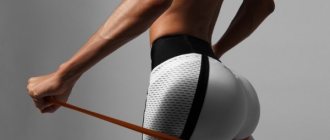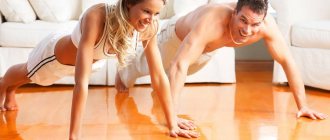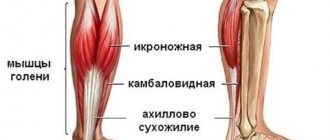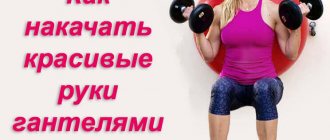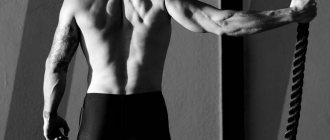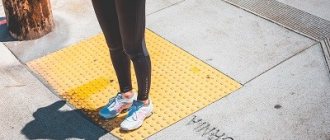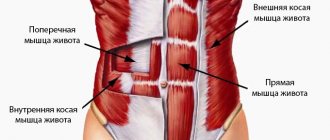Causes of excessive thinness of legs
The main reason for thin legs is genetic predisposition. This is a common problem for people with an ectomorphic body type (both women and men).
Features of the ectomorphic somatotype include:
- thin-boned skeleton (and hence weak osseous-ligamentous apparatus)
- narrow chest
- often long limbs
- low percentage of subcutaneous fat and muscle
To increase volumes, such people will have to try, putting in a lot of effort and time.
But this is not the only reason for excessive thinness. Other factors also influence this point:
- Adolescence
At this time, rapid growth and restructuring of the body occurs.
Adolescents often experience asynchronous, that is, uneven development of organs and systems. It happens that muscle tissue does not keep pace with bone growth.
This is where the disproportion in physique appears. For example, very long, but thin legs. As a rule, by the age of 18-20, the body “evens out” such physical defects on its own.
- Muscular atrophy of the legs due to injuries
This applies, for example, to fractures and subsequent prolonged wearing of a cast or diseases in which complete or partial immobilization occurs.
In most of these cases, this is a temporary problem . And a girl or guy can easily gain weight in their legs when they start doing basic physical exercises (walking, cycling, etc.).
- Professional activities related to the development of extreme endurance
Representatives of some sports (marathon runners, triathletes, road cycling marathon runners) have extremely thin legs, with “shrunken” thigh muscles.
This is easily explained by the specifics of the muscular activity of athletes.
To cover huge distances, body weight must be minimal. With the same amount of not only fat, but also muscle. Therefore, the body of such athletes “burns” everything unnecessary, including the leg muscles.
- Muscular dystrophy
It is considered a medical disease (not to be confused with skinny legs of ectomorphs), which is treated with medication. Including through the use of hormonal agents - insulin, growth hormone, anabolic steroids. Naturally, under strict medical supervision.
Tighten and pump up the muscles of the buttocks
There are several training complexes for the buttocks, depending on the desired result: losing weight, tightening muscles and reducing the size of the “fifth point”, getting rid of cellulite and even increasing the shape to achieve a “Brazilian butt”.
You can tighten and strengthen your buttocks with exercises that involve the use of weights (dumbbells or ordinary plastic bottles filled with sand).
During training, you should keep your back straight, tense the muscles of your buttocks and abdomen, and remember to breathe correctly. But the most important factor is the mini-break between exercises, which should not exceed 30 seconds.
A set of exercises to tighten the buttocks
- Lunges with alternating legs. From a standing position, perform a lunge (so that a 90° angle is formed between your legs) and stand straight again. The movements should be performed first with the right leg (for 1 minute), and then after a short break (no more than 30 seconds) with the left leg.
- Squats. Place your feet shoulder-width apart, clasp your hands with your palms in front of you. When squatting, you need to slightly move your body forward, trying not to extend your knees beyond the level of your feet. Perform movements for 1 minute.
- Jump up from a squat. You need to slowly squat down and jump as high as possible, tensing your leg muscles and stretching your toes. Execution time – 30 seconds.
- Bend forward using weight. Starting position: standing, feet shoulder-width apart, body straight. Within 1 min. you need to bend over while holding dumbbells or bottles of sand.
- Squats and weighted arm presses. From a standing position (with weight in your hands), you should squat deeply, and then straighten up and press your arms up.
- Taking your legs back and up. Standing on all fours, you need to move your right leg back and stretch, and then, pulling your toe, make several springy upward swings in half a minute. After a short rest, do the same with your left leg.
- Tilt the body back. Standing on your knees and holding your body straight, you need to lean back and reach your heels with your hands. Perform the exercise for a minute.
How to increase volumes
So, with the exception of muscular dystrophy, all cases of too thin legs are corrected. Theoretically, there are two ways to increase thigh volume - by storing fat, and by gaining muscle mass.
Due to fat accumulation
This is the “folk way,” so to speak. After all, logic dictates that since your legs are thin, it means you need to eat more. Excess calories will definitely lead to an increase in body fat and your legs will become larger. In theory, everything looks easy.
But in practice, this method only works on women with normal metabolism.
Once you relax in your diet and start overeating, you immediately begin to gain excess fat in your body. Including due to its accumulation on the hips.
One problem is that this method does not work for ectomorphs. Due to a very fast metabolism, it is not possible to gain weight even with an increase in caloric intake.
In such a situation, there is only one way to gain weight in the legs - to pump up the thigh muscles.
By building muscle mass
Practical bodybuilding experience shows that for ectomorphs with thin legs, pumping them up is quite possible.
Of course, under the influence of force loads they will not become as huge as those of professional athletes. But it will be possible to significantly increase the volume of the hips in comparison with the initial parameters. After all, building muscle mass is a fairly controlled process. Practical techniques for training legs to gain mass, developed over decades, will help with this.
The only thing that distinguishes ectomorphs from other body types is the rate of muscle growth.
In ectomorphs, muscles grow much slower, so to get the desired results, you will have to spend more time.
But there is good news - this body type gains, albeit slowly, but mostly “lean” muscle mass, that is, without fat.
Girls especially benefit from this. Their initially long but thin legs gradually gain the necessary muscle volume, gradually acquiring an aesthetically athletic appearance. As a result, the legs become moderately inflated, without visible excess fat and cellulite.
Why pump up girls' legs?
Inflated legs are necessary not only for people who do hard physical work or are athletes. Inflated lower limbs give a slim figure. Many girls want to improve their figure and start with their legs. Also, having toned legs can increase your endurance. If you perform the exercises regularly, you can get good results in a short period of time. Most exercises are performed without exercise equipment or weights, so a girl will not need complex equipment to pump up her legs at home.
Inflated lower limbs are not just beautiful. These exercises will help tone your body and improve your health. For example, squats help improve posture.
Training Recommendations
It will be easier to gain weight in your legs if you follow the main rules:
- Priority in the selection of exercises is given to basic movements with free weights - dumbbells, barbells or kettlebells
- Basic exercises performed in simulators are allowed, but as auxiliary exercises
The effectiveness of such movements in terms of gaining muscle mass is lower than from exercises with free weights.
- Frequency of leg training – 1-2 times a week
Don't forget that muscles grow during the rest period after strength training. By training your legs too often, you can slow down muscle growth due to insufficient recovery.
- The average number of leg exercises per workout is 4-5
2-3 movements are for the development of quadriceps (squats, lunges), 2 exercises for the hamstrings (types of deadlifts or bends).
If there is a need to further develop the calf muscles, the program includes 1-2 exercises for this muscle group - calf raises while standing or sitting.
- The number of working approaches in one exercise is 2-4
- Rep range – 10-15
- Rest pauses between sets – 2-3 minutes
- Load progression
A constant increase in load volume is a prerequisite for progress.
Strive from training to training to systematically increase the intensity of the session due to the number of approaches, increasing the working weight and other parameters.
A few words about nutrition
For ectomorphs, nutrition for muscle growth has certain specifics.
Protein is undoubtedly important for stimulating muscle growth. But for ectomorphs, carbohydrate consumption comes first.
Often it is its lack in the diet that inhibits muscle growth in people with this body type.
The daily intake of carbohydrates is the highest of all somatotypes - 7-8 grams per 1 kg of body weight. Some experts even recommend increasing your carbohydrate intake to 9-11 grams.
For comparison: the standard carbohydrate intake for other body types is 5-6 grams.
But with protein intake everything is as usual - 2 grams per 1 kg of body weight.
Ectomorphs may not take into account the amount of fat, since this nutrient is automatically gained when consuming such a large amount of food.
By the way, the total calorie content of the diet is also “high” - 50-60 kcal per 1 kg.
Even if you have a high metabolism and a good appetite, eating that much food is a difficult task. And this is where sports nutrition comes to the rescue.
One of the main advantages of sports nutritional supplements is that they can contain a large number of calories with a small intrinsic volume. This makes it easier to gain the required amount of proteins, carbohydrates and total calories.
In first place in terms of effectiveness for gaining muscle mass in the legs is a gainer. Often, only thanks to its use, thin people can increase their volume.
As practice shows, for ectomorphs, taking protein is less effective than using a gainer. Therefore, protein can be used, but only as an additional, auxiliary additive.
Taking creatine and vitamin-mineral complexes also brings results.
But popular amino acids (complex, BCAAs, individual types) are useless for ectomorphs during the period of weight gain.
We pump our legs at home.
So, let's get started, how to pump up your legs at home? There are several simple and quite useful exercises for this.
Squats.
This exercise is performed without additional equipment. The lower limbs become toned by using the weight of the entire body.
- Place your feet shoulder-width apart. Place your own body weight on your heels.
- Do a squat. At the same time, do not bring your knees too far forward; they should be at the level of your socks.
- Return to the starting position.
- Make sure that your muscles are tense when performing a squat.
Lunges.
- Stand straight and place your feet shoulder-width apart.
- Bending your knee at a right angle, take one leg back, placing it on your toes.
- Return to the original position. At the same time, pull your back leg towards your chest.
- Repeat the same, focusing on the second lower limb.
Plie squats.
- Take a standard squat position, but point your toes slightly out to the sides.
- Place your hands on your hips.
- Perform squats so that your thighs are parallel to the floor.
- While remaining in the squat, lift your heels off the ground.
- Hold the position for a few seconds and continue the exercise.
Side lunges.
- Stand straight and place your feet hip-width apart.
- Moving your pelvis back, take a step to the right, bending your knee.
- The left lower limb remains straight.
- Do a side lunge without bending your chest.
- Repeat the lunge on your left leg.
Climbing.
- Stand up straight.
- Raise your lower limb to hip level. Keep your balance.
- Tighten your muscles and stand on your toes on one leg.
- Lock in this position and lower back onto your heel.
- Repeat the exercise.
Lying ups.
- Lie on your side.
- Place your lower limbs directly on top of each other.
- Lift your top leg up.
- Do the exercise using your thigh and gluteal muscles.
- Repeat the steps.
Bridge.
- Take a lying position and bend your knees without lifting your feet off the floor.
- Keep your thighs parallel and straighten one leg, lifting it slightly.
- Push off from the floor, making sure your body forms a straight line.
- Leave the other leg bent at the knee.
- Repeat the steps on the other limb.
